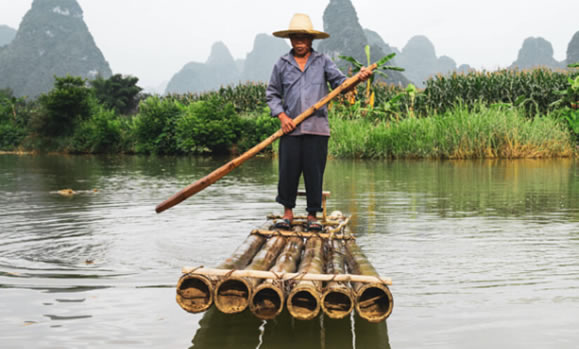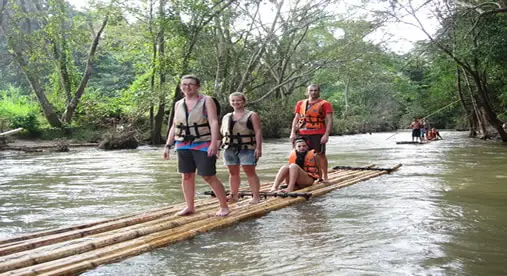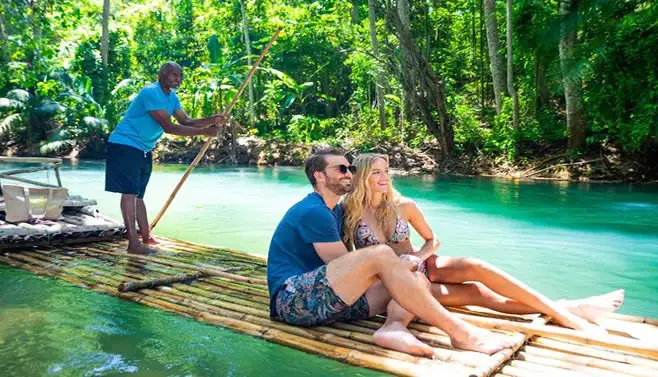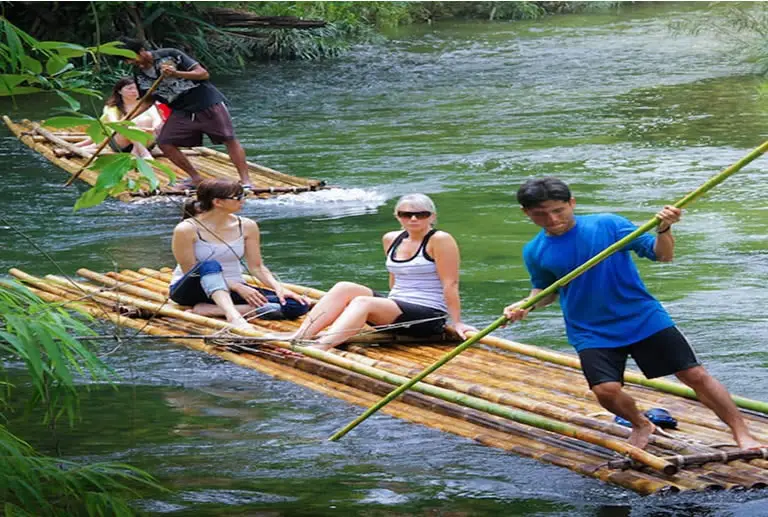Contents
The Basics Of The Bamboo Raft
A bamboo raft is a flat bottomed basic water craft made of bamboo stakes that are lashed together with vines or rope.
It is a very basic bamboo boat.
Bamboo rafts are designed to be used as a basic means of transportation, for fishing activities, recreational activities, and have even been utilized in survival situations.
A brief history of the raft
Nowadays, bamboo rafting is not only of great utility importance to people in remote parts of Asia, as well as some parts of Southern America.
However the raft is popular with people who enjoy fun outdoor water activities.

The use of non-powered rafts started way back in 3,000 BC when they were used as a basic means of water transportation when movement across bodies of water was required.
Because they have very little components and are easy to build rafts were one of the first types of watercraft invented.
Any type of material that is buoyant, traditionally wood logs, can be lashed together with vines from plants to create a flat floating surface; a raft.
Rafts were utilized in the early days of commerce, commonly utilized in bartering and trading.
It is also worth mentioning that this type of watercraft was the backbone for hauling and logging activities in the coastal and riverside communities of Asia and Southern America.
Many longing companies created create massive rafts made up of fallen trees and float them downstream to their destination for processing.
In some places this is still done today.
For more on the history and modern uses of different types of rafts read this article.
If you would like to know more about the construction methods for traditional and modern rafts read this article.
The evolution of the bamboo raft
Let’s dive deeper into the old-fashioned and modern significance of bamboo rafts.
One of the most common types of traditional raft that is still built and used today is the bamboo raft.
Some rafts, like the ones made from tree logs and timber, are still built and used today but not on the same scale as in the past.
Due to the declining sources of trees and concerns about the environment (which makes timber more expensive), making rafts like these is now beginning to decline.
The building of bamboo rafts, on the other hand, still survive due to fast growth and easily replenishment of bamboo, which is abundant in tropical areas such as Asia and South America.
Bamboo rafts in the early days were made using only sharp stones, using liana vines to lash together bamboo stakes.
Nowadays, with the technological advancement in producing knives and ropes, rural communities have found modern tools and materials more useful in making a more robust bamboo boat.
Some have also employed the use of varnish and oil for better maintenance of bamboo rafts to help them maintain their water resistance longer.
The evolution of the bamboo raft does not only benefit the rural communities who still use it, but also the tour operators that employ these rafts for recreational activities.

4 Modern uses for the traditional bamboo raft
As mentioned above bamboo rafts are routinely used for tours in places such as Thailand.
But, modern bamboo rafts have other, “working” purposes.
Here are four of the most common purposes typically associated with the modern use of bamboo rafts:
1. Transportation.
2. Fishing activities.
3. Recreational outdoor activities.
4. Emergency situations.
Let’s take a look at these activities in more detail.
Bamboo rafts are used for transportation
Bamboo rafts, believe it or not, are still one of the main ways for carrying people, goods and merchandise, and cargoes in certain areas of the world.
In Southeast Asia bamboo rafts are very popular.
Countries like the Philippines, Thailand and Vietnam have been employing these rafts to make river crossings for centuries right up to the present day.
Vessels like these are not only cheap and easy to make, they can also be deconstructed and used as materials for building more modern water vehicles like motorized bankas.
Bamboo rafts are still regularly used for fishing
Bamboo rafts are always imperative in certain areas for fishing activities in rivers, lakes and even the ocean.
It is an undeniable fact that a well-built modern boat, along with essential equipment, equates to a productive fishing experience.
But this is not to say that bamboo rafts, although basic in design, cannot compete with modern technology.
Commercial fishing and leisure fishing can both benefit from using bamboo rafts due to their practicality and the low cost associated with their production.
Bamboo rafts are used by first responders in many countries
We have seen it in movies and true-to-life accounts as well. Life rafts are used for emergency situations involving water accidents and disasters.
But should you ever find yourself stranded on a deserted island you may never be fortunate enough to get access to such a rigid and advanced emergency boat.
Now, this may be when a knowledge of building a simple raft comes in handy.
Bamboo is common on tropical islands, and therefore it is not hard to source and build bamboo rafts when the need arises.
During a deadly storm in the Philippines, one community found a use for bamboo rafts.
This is just one example of how a bamboo raft can be used in a challenging situation.
Bamboo rafting has become a huge tourist attraction
Outdoor activities are fast evolving due to the increasing demand for both extreme sports and water-based adventures.
There are many water-based extreme sports that rely on modern technology, such as speed boating. This is also the case for tourism, such as with airboat tours for example.
But for some tourists a more unsophisticated means of exploring a water-based experience is preferred.

Enter bamboo rafting.
Advertised as a great way for a jungle and river experience, bamboo rafting is increasingly becoming popular in regions where the focus of tourism centers around water-based activities.
It can be said that while inflatable rafts are a more common type for rafting experience, bamboo rafting offers more thrill, excitement, rawness and authenticity. This is because it is experienced in the jungle or on forest rivers and isolated lakes.
This activity started in Asia and gained popularity in the USA because more people want to experience a different type of authentic water adventure.
Bamboo rafting is an exceptional outdoor activity that is best enjoyed with family and friends.
The Basics Of The Bamboo Raft
We will now explore how the bamboo raft is built, how it is controlled and under what conditions it is used.
How bamboo rafts are built
In the early days, bamboo rafts were made with just sharp stones, bare hands, vines which were sourced from trees like Lianas, and bamboo stakes.
Nowadays, bamboo rafts are made stronger by using materials like, a sickle or knife, varnish, wood rope or nylon rope, along with the traditional bamboo.
Bamboo rafts are made as a simple watercraft that is designed to float freely without aid.
In essence, you only need a number of sturdy pieces of bamboo and long vines for lashing the bamboo pieces together in order to build one.
How a bamboo raft is propelled and steered
Riding a bamboo raft is not supposed to be difficult.
For experienced fishermen, people who use it for commuting, or for anyone using it for leisure activities, some knowledge in steering the raft with a piece of wood or long bamboo stalk will do.
The long stalk is used to both push and propel the raft in the same way you move a boat when punting.
Best & worst conditions for using a bamboo raft
Because a bamboo raft is a flat bottom boat with a very shallow draft it is best used in calm conditions.
As weather conditions always affect how the water behaves a bamboo boat is best used in calm weather.
Calm weather without too much wind is the best condition for bamboo rafting.
On the other hand, very windy weather conditions are not only inconvenient for bamboo rafting, they are also dangerous because of the unpredictable movement of water.
If on a tour, make sure the tour operator hands you the necessary life saving device such as a PFD.
Quick Recap: History, Uses, Benefits & Drawbacks Of The Bamboo Raft
A bamboo raft is a basic watercraft made from pieces of bamboo that are lashes together with durable tree vines or rope.
Bamboo rafts were used primarily for transportation and commercial activities as far back as 3,000 BC.
But, over the years, the utilization of this vessel has been expanded to adventure and recreational experiences.
Although there is a rawness in its appearance, a bamboo raft is comparable to other water vessels in terms of use and practicality.
Make no mistake, motorized boats are still king of the rivers, lakes, and oceans.
But, the humble bamboo boat can offer unique experiences to those seeking a more traditional way to navigate their local waters.
It also offers a more authentic experience for those wanting a great adventure home or abroad.
The biggest drawback to bamboo rafting is the same as any other flat bottom boat – it doesn’t handle well in rough water.

